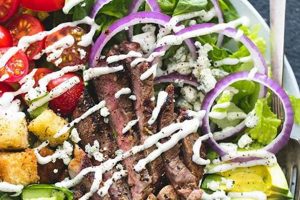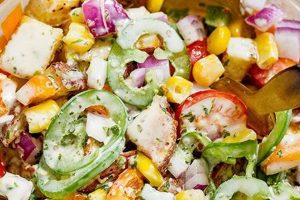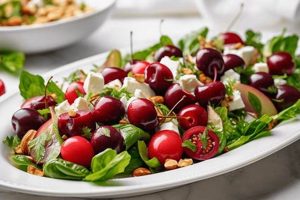Salads from Iran offer a refreshing counterpoint to the richer dishes often associated with Persian cuisine. Characteristically vibrant and herbaceous, these salads incorporate fresh produce like cucumbers, tomatoes, onions, and herbs such as parsley, mint, and dill. A simple dressing of olive oil, lemon juice, and sometimes verjuice, enhances the natural flavors. Examples include salad shirazi with its finely diced ingredients and salad olivieh, a more substantial salad featuring potatoes, chicken or other protein, and mayonnaise.
The emphasis on fresh, seasonal ingredients makes these salads not only delicious but also nutritious. They provide vitamins, minerals, and antioxidants, contributing to a balanced diet. Historically, access to fresh produce varied across the Iranian plateau, leading to regional variations in salad preparations. The use of herbs and aromatics reflects both culinary and medicinal traditions, with ingredients chosen for both their flavor and potential health benefits.
Further exploration will reveal the diversity within Iranian salad traditions, highlighting specific recipes, regional variations, and the cultural significance of these dishes within the broader context of Iranian cuisine.
Tips for Preparing Authentic Iranian Salads
Achieving the vibrant flavors of Iranian salads relies on a few key techniques and ingredient choices. Attention to detail ensures a truly authentic and enjoyable culinary experience.
Tip 1: Embrace Fresh Herbs: Generous use of fresh herbs is paramount. Parsley, mint, dill, and cilantro are common choices, adding brightness and complexity. Quality and freshness significantly impact the final flavor.
Tip 2: Fine Dice for Texture: Many Iranian salads, like salad shirazi, call for finely diced ingredients. This creates a pleasant texture and allows the flavors to meld harmoniously.
Tip 3: Simple Dressings Shine: Resist the urge to overcomplicate dressings. High-quality olive oil, fresh lemon juice, or verjuice often suffice, letting the fresh ingredients take center stage. A pinch of salt and black pepper completes the dressing.
Tip 4: Seasonal Produce is Key: Opt for the freshest, in-season produce available. Ripe tomatoes, crisp cucumbers, and sweet onions elevate the salad’s flavor profile. Local sourcing, when possible, enhances both flavor and sustainability.
Tip 5: Explore Regional Variations: Iranian salads offer regional diversity. Researching specific variations, such as those incorporating walnuts, pomegranate seeds, or dried herbs, expands culinary horizons.
Tip 6: Balance Flavors: Strive for a balance between acidity, saltiness, and the herbaceous notes from the fresh ingredients. Adjust seasonings carefully to achieve a harmonious blend.
Tip 7: Serve Immediately: For optimal flavor and texture, serve Iranian salads immediately after preparation. This prevents the vegetables from becoming soggy and maintains the vibrancy of the herbs.
By following these guidelines, one can create authentic Iranian salads that showcase the vibrant flavors and fresh ingredients characteristic of this cuisine. These tips contribute to a deeper understanding and appreciation of Iranian culinary traditions.
From understanding the core principles to exploring regional variations, crafting Iranian salads becomes a journey of culinary discovery.
1. Fresh Herbs
Fresh herbs constitute a cornerstone of Iranian salad recipes, contributing significantly to their distinctive flavors and aromatic profiles. Their presence elevates these salads beyond simple vegetable combinations, transforming them into vibrant culinary experiences. An exploration of key facets reveals the profound impact of fresh herbs in this culinary tradition.
- Aromatic Foundation
Fresh herbs provide the aromatic foundation of many Iranian salads. The herbaceous notes of parsley, dill, mint, and cilantro intertwine with the other ingredients, creating a complex flavor profile. For example, the bright, citrusy aroma of mint complements the sweetness of tomatoes in salad shirazi. This aromatic complexity distinguishes Iranian salads from those relying solely on vegetables.
- Flavor Enhancer
Beyond aroma, fresh herbs actively enhance the flavors of other ingredients. The peppery notes of parsley, for instance, can balance the sweetness of cucumbers and onions. Dill’s subtly tangy flavor adds depth to salads featuring yogurt or feta cheese. This interplay of flavors creates a well-rounded and satisfying culinary experience.
- Visual Appeal
The vibrant green hues of fresh herbs contribute significantly to the visual appeal of Iranian salads. The bright colors of parsley, mint, and dill create a visually striking contrast against the backdrop of tomatoes, cucumbers, and onions. This visual element enhances the dining experience, making the salads even more enticing.
- Nutritional Value
In addition to their culinary contributions, fresh herbs offer nutritional benefits. They are rich in vitamins, minerals, and antioxidants, adding a healthy dimension to these salads. Parsley, for example, is a good source of vitamins K and C. The inclusion of fresh herbs underscores the emphasis on both flavor and nutrition in Iranian cuisine.
The multifaceted role of fresh herbs in Iranian salad recipes is undeniable. From establishing the aromatic foundation to enhancing flavors, contributing visual appeal, and providing nutritional value, their presence is essential. Understanding this integral role provides a deeper appreciation for the artistry and complexity of Iranian cuisine.
2. Seasonal Produce
Seasonality plays a crucial role in Iranian salad recipes, influencing flavor profiles and reflecting a deep connection to the agricultural calendar. Emphasis on fresh, locally-sourced ingredients during their peak season ensures optimal taste and nutritional value. This approach highlights the importance of aligning culinary practices with the natural rhythm of the seasons.
- Peak Flavor and Nutrition
Utilizing seasonal produce guarantees the most vibrant flavors and highest nutritional content. Tomatoes ripened under the summer sun possess a sweetness and depth unmatched by those harvested out of season. Similarly, cucumbers picked at their peak offer a crispness and refreshing quality. This commitment to seasonal ingredients results in salads bursting with flavor and essential nutrients.
- Regional and Cultural Significance
The use of seasonal produce reflects regional agricultural patterns and cultural traditions. In regions known for specific fruits or vegetables, these ingredients feature prominently in local salad variations. For instance, areas with abundant pomegranate cultivation might incorporate pomegranate seeds into their salads during the fall harvest. This connection between local produce and culinary practices reinforces a sense of place and cultural identity.
- Variety and Adaptability
The changing seasons inspire culinary creativity and adaptability. Spring salads might feature tender herbs and early greens, while summer salads showcase ripe tomatoes and cucumbers. Fall brings an array of root vegetables and fruits like pomegranates, and winter salads might incorporate preserved vegetables or dried herbs. This adaptability ensures a diverse and exciting culinary landscape throughout the year.
- Sustainability and Environmental Consciousness
Prioritizing seasonal produce supports sustainable agricultural practices and reduces environmental impact. Consuming locally-sourced, in-season ingredients minimizes transportation distances and associated carbon emissions. This approach aligns with a growing awareness of environmental responsibility and promotes a more sustainable food system.
The emphasis on seasonal produce in Iranian salad recipes underscores a commitment to flavor, nutrition, cultural heritage, and environmental consciousness. By embracing the natural rhythm of the seasons, these salads offer a taste of place and a connection to the land, enriching both the culinary and cultural experience.
3. Simple Dressings
Simple dressings are a defining characteristic of Iranian salad recipes. They exemplify a philosophy that prioritizes the natural flavors of fresh, high-quality ingredients. Rather than masking these inherent flavors, simple dressings enhance and complement them, creating a harmonious balance. This approach underscores the importance of restraint and precision in Iranian cuisine.
- Highlighting Freshness
Simple dressings, often composed of little more than olive oil, lemon juice, and salt, allow the freshness of the produce to shine. The clean, bright flavors of the dressing do not compete with but rather amplify the taste of ripe tomatoes, crisp cucumbers, and fragrant herbs. This emphasis on freshness aligns with the broader culinary principles of Iranian cuisine.
- Balancing Flavors
A simple dressing acts as a unifying element, balancing the diverse flavors within the salad. The acidity of lemon juice tempers the sweetness of onions and tomatoes, while the olive oil provides a smooth, rich counterpoint. A pinch of salt enhances all the flavors, bringing them into harmony. This careful balancing of flavors is a hallmark of Iranian cooking.
- Versatility and Adaptability
The simplicity of these dressings allows for versatility and adaptation based on available ingredients and personal preferences. Verjuice, a sour grape juice, can be substituted for lemon juice, adding a unique tartness. Dried herbs or spices can be incorporated to add depth and complexity. This adaptability reflects the resourcefulness and regional variations within Iranian culinary traditions.
- Health and Nutritional Benefits
Simple dressings, made with minimal ingredients, contribute to the overall healthfulness of Iranian salads. Olive oil, a staple of the Mediterranean diet, provides healthy fats and antioxidants. Fresh lemon juice is a source of Vitamin C. This focus on wholesome ingredients aligns with the emphasis on nutrition in Iranian cuisine.
The use of simple dressings in Iranian salad recipes demonstrates a deep respect for the inherent qualities of fresh ingredients. This approach allows the natural flavors to take center stage, resulting in salads that are both refreshing and flavorful. By understanding the role of simple dressings, one gains a deeper appreciation for the nuances and sophistication of Iranian culinary traditions.
4. Vibrant Colors
Vibrant colors constitute a significant element within Iranian salad recipes, contributing to both aesthetic appeal and cultural meaning. The deliberate use of colorful ingredients extends beyond mere visual presentation; it reflects an appreciation for the natural beauty of food and its connection to the surrounding environment. This emphasis on visual appeal enhances the dining experience, making these salads a feast for the eyes as well as the palate.
The array of colors typically found in Iranian salads signifies freshness and vitality. Deep red tomatoes, vibrant green cucumbers, herbs, and white onions create a visually striking contrast. The strategic combination of these colors reflects an inherent understanding of color theory and its impact on sensory perception. For example, the inclusion of deep purple sumac or bright orange carrots elevates the visual appeal, stimulating appetite and creating a sense of anticipation. Furthermore, the colors often symbolize regional variations, with specific ingredients reflecting the agricultural diversity of different areas within Iran.
Understanding the role of vibrant colors in Iranian salad recipes provides insight into the cultural significance of food presentation. It highlights a culinary tradition that values not only flavor and nutrition but also the aesthetic qualities of a dish. This attention to detail elevates the dining experience, transforming a simple salad into a celebration of color, texture, and flavor. The visual appeal also plays a practical role, encouraging consumption, particularly among children, and contributing to a balanced and enjoyable diet. Ultimately, the vibrant colors in Iranian salads represent a deeper appreciation for the artistry and cultural richness embedded within Iranian culinary traditions.
5. Regional Variations
Regional variations within Iranian salad recipes offer a compelling lens through which to examine the diverse culinary landscape of the country. These variations are not merely superficial alterations but reflect deeper influences such as climate, available local produce, and distinct cultural preferences. Understanding these regional nuances provides valuable insight into the complex interplay between geography, culture, and cuisine.
The availability of specific ingredients often dictates regional adaptations. Coastal regions, with access to fresh seafood, might incorporate ingredients like shrimp or fish into their salads. Inland areas, abundant in nuts and dried fruits, feature variations incorporating walnuts, pistachios, or barberries. For instance, salads from the northern Caspian region often incorporate locally-grown olives and citrus fruits, while those from the arid regions of central Iran might utilize dried herbs and preserved vegetables. These examples demonstrate a direct link between regional produce and resulting salad compositions.
Cultural preferences also play a significant role in shaping regional variations. Spice preferences differ across regions, impacting the flavor profiles of the dressings. Some areas favor the use of sumac, a tart spice, while others prefer a simpler dressing of olive oil and lemon. The inclusion of specific herbs and vegetables also reflects regional culinary traditions. These cultural nuances contribute to a rich tapestry of salad variations, each reflecting the unique identity of its region. Examining these regional adaptations provides a deeper understanding of Iranian culinary heritage and the diverse factors that shape its evolution.
6. Textural Contrast
Textural contrast forms a crucial element in Iranian salad recipes, elevating them beyond simple mixtures of ingredients to complex sensory experiences. The interplay of different textures adds depth and interest, enhancing enjoyment and reflecting a sophisticated understanding of culinary principles.
- Crispness and Tenderness
A common textural interplay in Iranian salads involves the juxtaposition of crisp and tender elements. The crispness of cucumbers, radishes, or lettuce contrasts with the tenderness of tomatoes, herbs, or cooked vegetables like beets. This contrast provides a dynamic mouthfeel, stimulating the palate and adding complexity to each bite. Salad Shirazi, for example, exemplifies this contrast with its crisp cucumbers and onions alongside juicy tomatoes.
- Smoothness and Crunch
Another frequently encountered textural contrast involves the combination of smooth and crunchy elements. Smooth ingredients, such as feta cheese or yogurt, provide a creamy counterpoint to crunchy components like toasted nuts, seeds, or croutons. This textural interplay adds a satisfying dimension to the salad, creating a more complete and enjoyable culinary experience. Adding toasted walnuts to a salad with feta offers a prime example.
- Softness and Chewiness
Dried fruits, such as barberries or raisins, introduce a chewy texture that contrasts with the softer textures of fresh vegetables and herbs. This contrast not only adds textural interest but also introduces a subtle sweetness, enhancing the overall flavor profile. Salads incorporating dried fruits showcase this textural interplay, offering a nuanced sensory experience.
- Size and Shape Variation
Varying the size and shape of ingredients contributes to textural diversity. Finely diced cucumbers and tomatoes provide a delicate texture, while larger pieces of herbs or lettuce offer a more substantial bite. This variation prevents monotony and keeps the palate engaged. The combination of finely chopped herbs and larger pieces of vegetables in many Iranian salads demonstrates this principle.
The careful consideration of textural contrast in Iranian salad recipes highlights the sophistication of this culinary tradition. The interplay of different textures elevates these salads from simple combinations of ingredients to complex culinary creations that engage all the senses. This attention to detail contributes to a more satisfying and enjoyable dining experience, showcasing the depth and artistry of Iranian cuisine.
7. Balancing Flavors
Balancing flavors constitutes a fundamental principle in Iranian salad recipes, reflecting a deep understanding of culinary harmony. This principle goes beyond simply combining ingredients; it involves a careful orchestration of tastes to create a nuanced and satisfying whole. The interplay of sweet, sour, salty, bitter, and umami elements forms the foundation of this balancing act, resulting in salads that are both refreshing and complex. This careful consideration of flavor profiles distinguishes Iranian salads and contributes to their unique character.
The concept of balance manifests in various ways within Iranian salad recipes. The sweetness of ripe tomatoes, for example, finds its counterpoint in the acidity of lemon juice or verjuice. The sharpness of onions is tempered by the herbaceousness of fresh herbs like mint and parsley. Salty elements, such as feta cheese or a sprinkle of sea salt, enhance the overall flavor profile, while the occasional inclusion of bitter greens or herbs adds depth and complexity. The interplay of these contrasting flavors creates a dynamic tension that keeps the palate engaged. Salad Shirazi, a classic Iranian salad, exemplifies this balance, harmonizing the sweetness of tomatoes, the sharpness of onions, and the refreshing notes of cucumbers and herbs.
Achieving balance requires careful attention to ingredient selection and proportion. Overemphasis on any single flavor can disrupt the harmony of the salad. Therefore, Iranian cooks often employ subtle adjustments, adding a touch more lemon juice or a pinch of salt to fine-tune the balance. This nuanced approach reflects a deep respect for the interplay of flavors and an understanding of how to create a harmonious culinary experience. Mastery of this balancing act distinguishes skilled Iranian cooks and contributes to the enduring appeal of these salads. This principle, deeply embedded within Iranian culinary tradition, elevates simple combinations of ingredients to complex and satisfying dishes. Understanding this emphasis on balance provides a deeper appreciation for the artistry and sophistication of Iranian cuisine.
Frequently Asked Questions about Iranian Salads
This section addresses common inquiries regarding Iranian salads, providing concise and informative responses to clarify potential uncertainties and enhance understanding of these culinary creations.
Question 1: What distinguishes Iranian salads from salads of other cuisines?
Iranian salads emphasize fresh herbs, seasonal produce, and simple dressings that enhance natural flavors. The focus on finely diced ingredients and the balance of textures and tastes distinguish them from salads that rely heavily on leafy greens or complex dressings.
Question 2: Are Iranian salads suitable for specific dietary restrictions?
Many Iranian salads are naturally vegetarian, vegan, and gluten-free. However, variations incorporating yogurt, feta cheese, or meat exist. Careful examination of specific recipes is recommended for individuals with dietary restrictions.
Question 3: What are some common ingredients used in Iranian salads?
Common ingredients include cucumbers, tomatoes, onions, fresh herbs (parsley, mint, dill, cilantro), olive oil, lemon juice, and verjuice. Regional variations may incorporate ingredients like walnuts, barberries, pomegranate seeds, or dried herbs.
Question 4: How does seasonality impact Iranian salad recipes?
Seasonality plays a crucial role, influencing the choice of ingredients. Emphasis is placed on using fresh, locally-sourced produce at its peak ripeness, resulting in optimal flavor and nutritional value.
Question 5: What are some popular types of Iranian salads?
Salad Shirazi, with its finely diced cucumbers, tomatoes, and onions, is perhaps the most well-known. Salad Olivieh, a heartier salad with potatoes, chicken or other protein, and mayonnaise, is another popular choice.
Question 6: Where can one find authentic Iranian salad recipes?
Authentic recipes can be found in Persian cookbooks, reputable online culinary resources, and through cultural exchange with individuals familiar with Iranian cuisine.
Understanding the key characteristics and regional variations of Iranian salads allows for greater appreciation of this culinary tradition. Exploration of these vibrant and flavorful dishes offers a rewarding culinary experience.
Further exploration of specific recipes and regional variations provides a deeper understanding of Iranian culinary heritage.
Iranian Salad Recipes
Exploration of Iranian salad recipes reveals a culinary tradition deeply rooted in fresh, seasonal ingredients and a philosophy of balanced flavors. From the ubiquitous salad shirazi to regional variations incorporating diverse herbs, nuts, and fruits, these salads exemplify a cuisine that values simplicity, vibrancy, and nutritional value. The emphasis on fresh herbs, the strategic use of simple dressings, and the attention to textural contrast demonstrate a sophisticated understanding of culinary principles. Regional adaptations further highlight the diverse culinary landscape of Iran, reflecting the influence of local produce and cultural preferences.
Iranian salad recipes offer a gateway to a richer understanding of Iranian culinary heritage. Continued exploration of these dishes promises not only a delightful culinary experience but also a deeper appreciation for the cultural significance of food and its connection to the environment. Further investigation into regional variations and the adaptation of these recipes to modern kitchens offers a path toward preserving and celebrating this vibrant culinary tradition.





